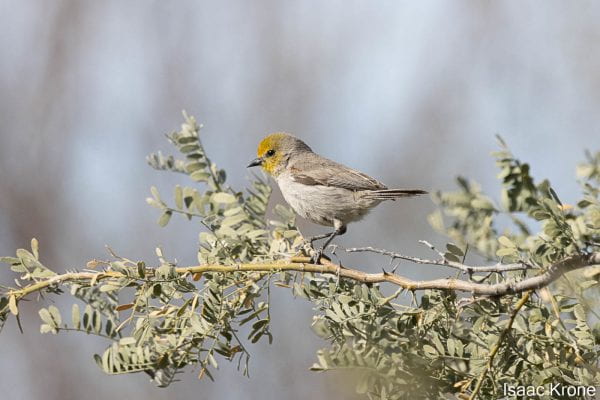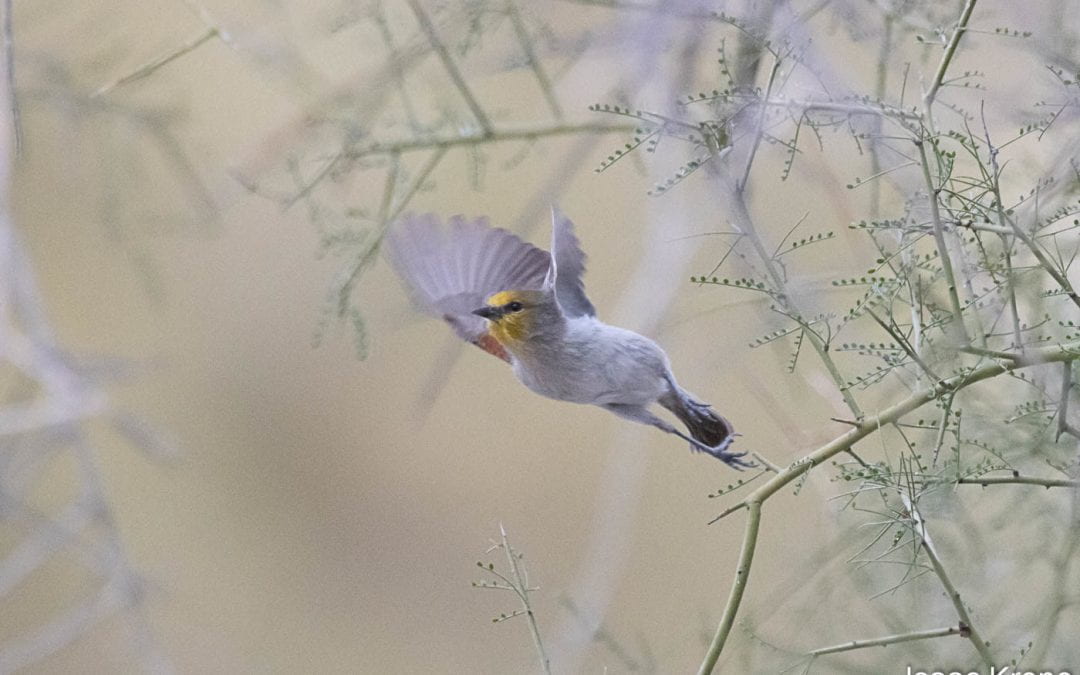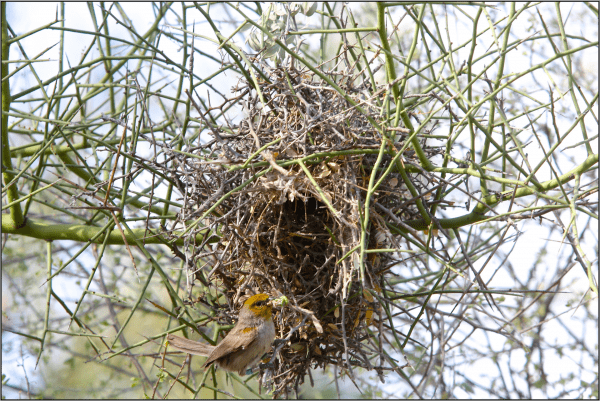Arizona’s Organ Pipe Cactus National Monument is filled with plants and animals uniquely suited to the area’s extreme temperatures and parched air. What may seem like an inhospitable desert is in fact home to an abundance of cacti, trees and flowers, as well as animals such as bats, reptiles and birds. When researchers Emma Greig, Max Witynski and collaborators set up camp in the Sonoran Desert, they were interested in one animal in particular—a bird, called a verdin.
“When you’re walking along these desert washes, the verdin is one of the birds that you’ll be most aware of,” said Witynski, a current UChicago News writer who was an undergraduate researcher on the project. “They are evocative of the landscape in a very special way.”

A verdin sits on a branch, observing and listening. Credit: Isaac Krone via iNaturalist
The verdin, a small, gray bird with a yellow head, is the only species of its family in the Americas and is found exclusively in desert habitats. But verdins may be even more specialized than this, since each of the desert environments in the American Southwest in which they live has its own distinct weather pattern, topography and vegetation.
“There was reason to imagine that there might be some adaptation to these different habitats,” explained Greig, who first worked in the Sonoran Desert as a UChicago graduate student and is now a Project Leader at the Cornell Lab of Ornithology.
In particular, Greig and her team were interested in whether verdins have distinct dialects. “Maybe the Chihuahuan Desert verdins sound different from Sonoran Desert verdins, which sound different from the Mojave Desert verdins,” Greig suggested.
To investigate whether verdin songs differ significantly across southwestern desert habitats, the researchers first developed a way to systematically compare them. Utilizing hundreds of recordings—some collected first-hand by Greig’s team and others gathered from the Macaulay Library at the Cornell Lab of Ornithology and xeno-canto database—the researchers identified the defining features of verdins’ “whistle songs” and compared these features across habitats.
For the simple tones of the verdin’s song, the researchers focused on comparing songs’ lengths and high and low frequencies, as well as quantifying the shape of each song when represented on a time vs. frequency plot. Applying these metrics to their assembly of bird songs, Greig and her team found that geographic patterns emerged across verdins of differing habitats.
“Thanks to lots of people running around, recording verdins over the years and putting their recordings in these collections, suddenly we have a geographic representation of verdins across the Southwest,” said Greig.
Once the team had confirmed the existence of acoustic variation in verdin songs across geographic regions, it set out to determine whether the verdins themselves could recognize these differences. The study was published on May 8 in Ornithology.
Usually, it is important for birds to be able to differentiate between their own species and other closely related species. Otherwise, they may waste time and energy attempting to attract, for example, a bird that sounds familiar but isn’t actually one of their own kind. But verdins don’t have this problem—their only other family members live in the “Old World,” or Africa, Asia and Europe.
“If verdins don’t have to avoid birds that sound similar,” thought Greig, “maybe they will respond to anything that sounds similar.”
To test this, the researchers headed to Organ Pipe, in the Sonoran Desert, during the verdin’s nesting season, equipped with a set of recordings of bird songs from various regions: the Sonoran verdin whistle song, a Chihuahuan or Baja verdin song, and an Old World song belonging to a related species (another member of the verdin’s family, Remizidae).
Once one of the small, spherical verdin nests had been spotted, a team member or two would conceal themselves in the desert brush, play one of the recordings from a speaker, and observe the verdins’ responses.
The verdin’s responses were categorized into movements (whether or not a bird approached the speaker, how long it took to approach the speaker, and the time spent near the speaker) and vocalizations (whether a bird sang a whistle song, how long it took to sing a song, and the total number of songs sung).
Just like with many other types of birds, the Sonoran verdins sang significantly more songs in response to recordings of their own, local songs than foreign ones. Surprisingly, however, they were equally likely to approach each of the North American recordings. Altogether, this meant that they could indeed distinguish between songs, but chose to investigate them indiscriminately.
“Right away,” said Greig, “they would come and investigate these songs that sound quite different. I thought, ‘Whoa! That’s kind of weird!’”
The researchers hypothesize that the reason verdins were eager to approach the speaker in most cases, while not being equally willing to respond vocally, is likely due to a unique set of motivations. In other words, perhaps the benefits of physically investigating foreign songs outweigh the risks, while those of singing more songs in response do not.
The study’s results not only tell us something new about verdins, a unique North American desert songbird, but further our understanding of the way birds—especially those highly specialized for their habitats—interact and communicate with each other.
To build on the work and take it in new directions, Greig encourages other researchers to utilize the full data set included with the publication. Just like the available depositories of bird songs that her team drew from for this study, Greig hopes that the dataset generated by her investigation will support new research.
This work also represents a milestone in the efforts of Greig and Eric Larsen, UChicago senior lecturer and senior author, to teach UChicago undergraduates about the nature of the southwestern deserts.
Originally designed as summer teaching excursions for students, Greig and Larsen have been leading trips to Organ Pipe since 2006. These evolved into spring research trips in 2015, which eventually led to this investigation. That progression makes the work even more impactful for Greig: “The fact that this study could come out of that long history of undergraduate training is really exciting.”
By Amanda Parker, PhD


